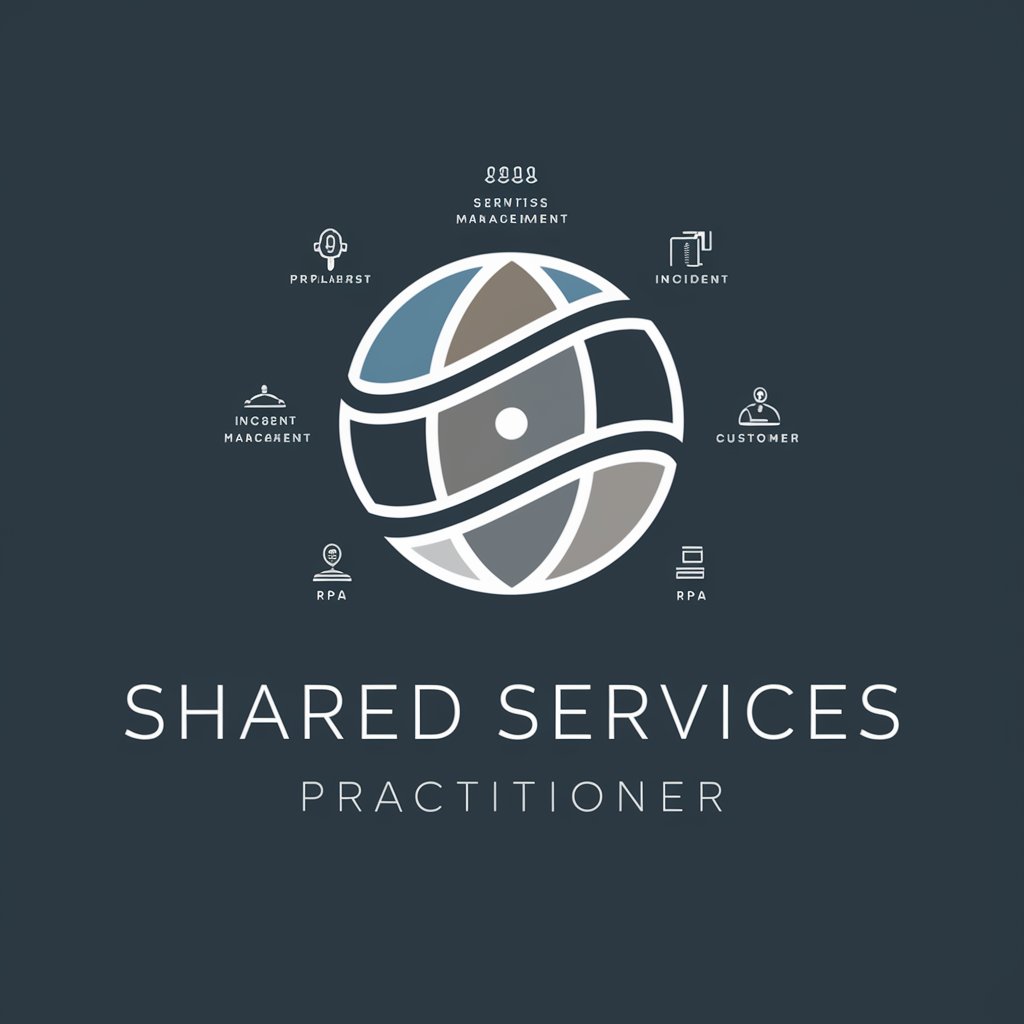
Shared Services Practitioner - Expert Advice on Shared Services

Welcome! How can I assist you with shared business services today?
Empowering Shared Services with AI
Can you explain the key benefits of implementing a shared services model?
What are the best practices for managing global process ownership?
How can businesses effectively implement robotic process automation (RPA) in their operations?
What strategies can improve customer experience in a shared services environment?
Get Embed Code
Introduction to Shared Services Practitioner
A Shared Services Practitioner is a professional or entity specializing in the consolidation of business operations that are used by multiple parts of the same organization, aiming to achieve efficiency, service improvement, and cost reduction. This concept is built around the centralization of back-office functions such as finance, HR, IT, and procurement, allowing different departments to share internal resources instead of duplicating efforts. For instance, rather than each department having its own HR team, a centralized shared services center would handle HR tasks for the entire organization. This model is designed to optimize the delivery of non-core services, standardize processes, and focus on strategic business objectives. Powered by ChatGPT-4o。

Main Functions of Shared Services Practitioner
Process Standardization
Example
Implementing a unified invoice processing system across all departments.
Scenario
A corporation operating in multiple locations had each branch handling invoices differently, leading to inefficiencies and errors. By centralizing this function, the organization streamlined operations, reduced costs, and improved compliance.
Cost Reduction
Example
Centralizing IT support services to serve multiple business units.
Scenario
A multinational company used to have separate IT support teams in each country. Consolidating these teams into a single, shared IT service center reduced redundancy, decreased operational costs, and enhanced service quality.
Service Improvement
Example
Upgrading the HR portal to provide self-service capabilities for employees across various departments.
Scenario
An organization identified that its HR queries handling was slow and inefficient. By upgrading the HR portal, it enabled employees to perform tasks like leave applications and benefits management themselves, leading to higher satisfaction and freeing HR staff to focus on strategic tasks.
Demand Management
Example
Implementing a ticketing system to prioritize and manage IT service requests from all departments.
Scenario
Faced with overwhelming IT requests, a company introduced a ticketing system through its shared services center. This system helped in prioritizing tasks based on urgency and complexity, ensuring critical issues were addressed promptly while managing expectations across the organization.
Ideal Users of Shared Services Practitioner Services
Large Corporations
Organizations with multiple business units or geographical locations stand to benefit significantly. They can achieve cost efficiencies and operational improvements by centralizing non-core functions like HR, IT, and finance.
Government Agencies
Public sector entities often face budget constraints and efficiency pressures. Shared services allow them to consolidate similar functions across different agencies, reducing costs and improving service delivery to the public.
Mid-sized Businesses
As they grow, these businesses can find value in shared services by streamlining operations and focusing on their core competencies, thus improving competitiveness without the overhead of fully staffed departments for non-core functions.

How to Utilize Shared Services Practitioner
Initiate Your Journey
Start by visiting yeschat.ai to explore Shared Services Practitioner through a free trial, accessible immediately without the need for a login or subscribing to ChatGPT Plus.
Define Your Needs
Identify your specific questions or challenges related to shared business services, such as process optimization, incident management, or customer experience enhancement.
Engage with the Tool
Use the inquiry field to pose your questions or describe the scenario you need assistance with, providing as much detail as possible to get tailored advice.
Explore Additional Features
Leverage follow-up questions to dive deeper into any topic or request case studies and examples for real-world insights and applications.
Apply Insights
Implement the advice and best practices shared by the tool in your organizational context to enhance your shared services framework and achieve operational excellence.
Try other advanced and practical GPTs
SHEQ
Elevate your QHSE practices with AI

Handoff
Streamlining Patient Care Transitions with AI

Arizona Notary Assistant
Empowering Arizona Notaries with AI

GrowthGPT
Empowering Startups with AI-Driven Growth Strategies

SEO Strategy Assistant
Tailored SEO Strategies, AI-Powered Insights

SolConGPT
Empowering Sales Success with AI

Currículo Inteligência Artificial
Craft Your Professional Identity with AI

Mongos Aus Skill
Empowering MongoDB Success with AI

🟨Especialista em Marketing B2B
Empower your B2B strategy with AI-driven insights

PDF Processor Pro
Decipher PDFs with AI-powered precision

Gerador de Capítulos
Craft Your Story with AI Power

Digitus
Elevate Your Social Content with AI

Detailed Q&A on Shared Services Practitioner
What is Shared Services Practitioner?
Shared Services Practitioner is an AI-powered tool designed to provide expert advice on shared business services. It covers domains such as process optimization, global process ownership, and customer experience, offering detailed insights to improve efficiency and effectiveness.
How can Shared Services Practitioner aid in process optimization?
It offers actionable advice on streamlining business processes, identifying inefficiencies, and implementing best practices for optimization. Users can gain insights into leveraging technologies like RPA for automating repetitive tasks, thus improving overall operational efficiency.
Can it help with customer experience enhancement?
Absolutely. The tool provides strategies for enhancing customer interactions and service delivery. It emphasizes the importance of understanding customer needs, feedback analysis, and applying these insights to drive continuous improvement in service quality.
Is Shared Services Practitioner suitable for incident management?
Yes, it provides guidance on establishing effective incident management frameworks. This includes advice on creating clear processes for incident reporting, resolution, and analysis to minimize impact on business operations and enhance resilience.
How can organizations implement the advice given by Shared Services Practitioner?
Organizations can apply the insights by aligning them with their specific business contexts. This includes integrating suggested frameworks, technologies, and best practices into their existing processes, and continuously monitoring for improvements and adjustments as needed.





